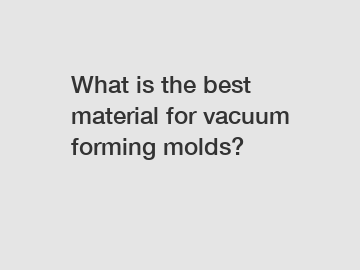What is the best material for vacuum forming molds?
What is the best material for vacuum forming molds?
When it comes to vacuum forming molds, choosing the right material is essential for achieving high-quality results. The material used for molds greatly impacts the efficiency, durability, and overall success of the vacuum forming process. In this article, we will explore the various materials commonly used for vacuum forming molds, discuss their pros and cons, and ultimately determine the best material for this purpose.
1. Aluminum:

Aluminum is a popular choice for vacuum forming molds due to its excellent heat conductivity and lightweight nature. It allows for efficient heat transfer, ensuring a consistent temperature throughout the mold. Its low weight also makes it easier to handle and maneuver. However, aluminum molds may not be the best choice for large or complex parts as they can warp under high temperatures and require additional support structures.
2. Wood:
Wood is another common material used for vacuum forming molds, especially for low-cost prototyping or small-scale projects. It is relatively easy to work with and can be readily machined into the desired shape. However, wood is not suitable for high-volume production runs as it tends to absorb moisture, leading to warping or distortion. Additionally, the porous nature of wood may hinder the release of the formed part from the mold.
3. Composite materials:
Composite materials, such as fiberglass or carbon fiber, offer unique advantages for vacuum forming molds. They possess high strength and rigidity, making them ideal for creating intricate mold designs. Composite molds are known for their longevity and resistance to warping even under high temperatures. However, these molds can be more expensive to produce and require specialized skills and equipment for fabrication.
4. Epoxy or urethane resins:
Epoxy and urethane resins have gained popularity in recent years due to their versatility and ability to capture fine details. They are often used for low-volume manufacturing or prototyping purposes. Resin molds offer excellent dimensional stability and are less prone to warping compared to other materials. However, they may require additional coatings or releases agents to ensure easy part removal.
Considering the pros and cons of each material, it becomes evident that there is no one-size-fits-all answer to the question of the best material for vacuum forming molds. The choice depends on various factors, including budget, project requirements, and expected production volume. For small-scale projects or prototyping, wood or resin molds may suffice, while aluminum or composite materials are better suited for larger production runs or complex parts.
In conclusion, understanding the characteristics and limitations of different materials for vacuum forming molds is crucial in achieving optimal results. While aluminum offers good heat conductivity and lightweight properties, wood provides affordability but may lack durability. Composite materials stand out in terms of strength and rigidity, while epoxy or urethane resins offer versatility and fine detail capturing capabilities. Carefully evaluating the project's specific needs will help in determining the best material for vacuum forming molds and ensure successful outcomes in the manufacturing process.
Contact us to discuss your requirements of vip logo car, Hebei Shuiyuan Trading CO.,Ltd, car floor mat making machine. Our experienced sales team can help you identify the options that best suit your needs.


